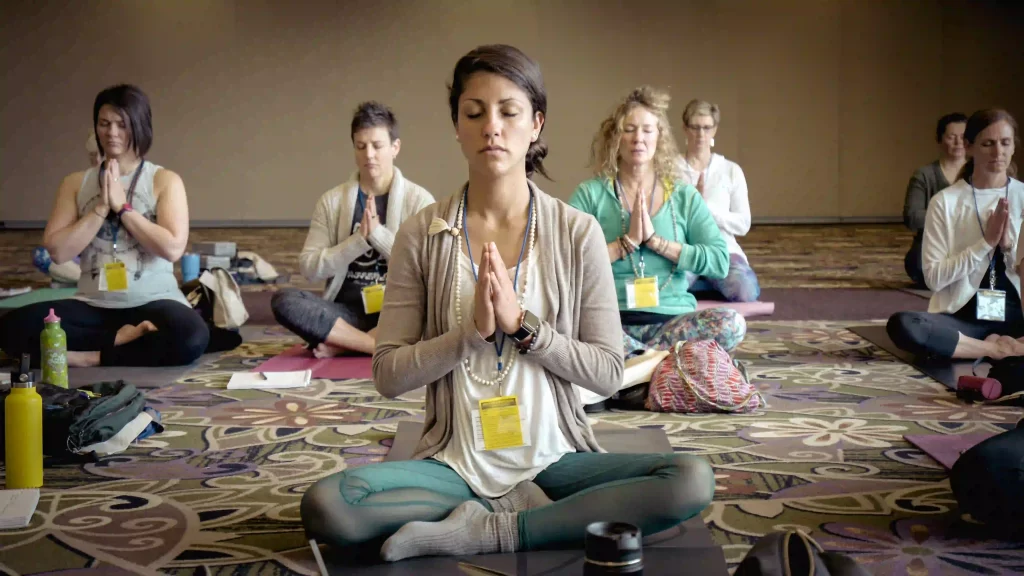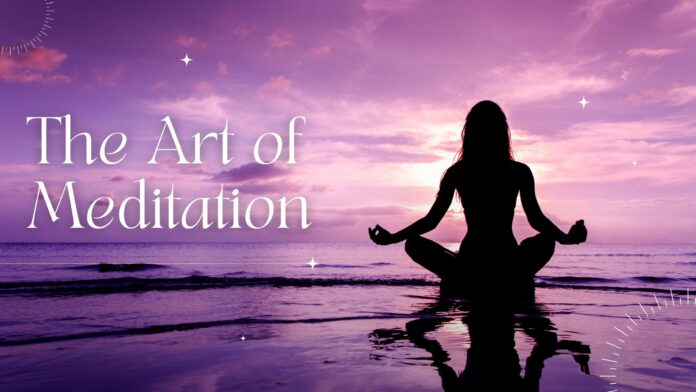Last Updated on August 9, 2023 by Shane Corbitt
An Unexpected Journey: Exploring the Depths of Meditation
Definition and Purpose of Meditation
Meditation, often regarded as an ancient practice, is a profound art that offers a doorway to inner peace and self-discovery. At its core, meditation is the act of focusing one’s attention and clearing the mind in order to reach a heightened state of consciousness. It is not about emptying the mind entirely but rather about observing thoughts without judgment and cultivating a deep sense of presence in the present moment.
Regular meditation allows individuals to develop a heightened awareness of their thoughts, emotions, and physical sensations. The purpose of meditation varies across different traditions and personal beliefs.
For some, it serves as a means to quieten the noise within, finding solace in stillness amidst the chaos of daily life. Others seek spiritual growth or connection with their higher selves or something greater than themselves.
Furthermore, there are those who approach meditation as a tool for stress reduction and mental well-being. Regardless of one’s intention behind engaging in this practice, meditation offers an opportunity to explore one’s inner landscape with curiosity and self-compassion.
Historical Origins and Cultural Significance
The roots of meditation can be traced back thousands of years ago across various cultures around the world. It has been practiced by ancient civilizations in India, China, Japan, Greece, Egypt, and beyond.
In India specifically, meditation emerged within Hinduism as early as 1500 BCE through yogic practices that aimed to attain self-realization or union with Brahman—the ultimate reality. Buddhism significantly spread meditation beyond India’s borders during the 5th century BCE when Siddhartha Gautama (later known as Buddha) attained enlightenment through deep contemplation under the Bodhi tree.
The Buddhist tradition emphasizes mindfulness and insight meditations as essential practices to alleviate suffering and gain spiritual insight. Over time, meditation practices found their way into different cultures and belief systems, adapting to each context.
In Japan, Zen Buddhism introduced zazen, a seated meditation technique that emphasizes direct experience and non-conceptual awareness. Taoist traditions in China incorporated meditation as a means to cultivate balance and harmony between the mind, body, and nature.
In today’s world, meditation has transcended cultural boundaries and gained popularity across diverse communities. Its significance spans far beyond religious or spiritual contexts—many individuals turn to meditation as a means of self-improvement or stress management in our fast-paced modern lives.
Meditation’s historical origins and cultural significance continue to shape its various forms and approaches today. It is through understanding its roots that we can appreciate the depth of this timeless art form, which holds the potential to enrich our lives in unexpected ways.

Benefits of Meditation
Physical Benefits: Stress Reduction and Improved Sleep
When it comes to the physical benefits of meditation, stress reduction is at the top of the list. In our fast-paced, modern lives, stress seems to be an unwelcome companion we can’t shake off. However, through the practice of meditation, we can find a sense of calm amidst the chaos.
Studies have shown that regular meditation helps activate the parasympathetic nervous system, which is responsible for deep relaxation and reduced stress levels. This brings a sense of peace and contributes to better overall health.
Another physical benefit worth mentioning is improved sleep quality. Many individuals struggle with falling asleep or having restful nights due to busy minds and endless worries.
Meditation acts as a natural sedative for both body and mind by promoting relaxation before bedtime. By meditating in the evening, you can create a soothing atmosphere and clear your head from all those racing thoughts that often keep us awake at night.
Mental and Emotional Benefits: Increased Focus and Reduced Anxiety
Maintaining focus in our increasingly distracting world has become quite a challenge for many individuals. Fortunately, meditation offers an effective solution. Regularly practicing meditation enhances our ability to concentrate by training our minds to stay present in the here and now.
As we cultivate this mental discipline through techniques like mindfulness meditation, we gradually develop better cognitive skills, such as improved memory retention and enhanced attention span. Apart from sharpening our focus, meditation also aids in reducing anxiety levels.
Anxiety often stems from excessive worrying about future events or dwelling on past experiences. Through mindfulness-based practices like breath awareness or body scan techniques, one learns to be fully present in each moment rather than getting caught up in anxious thoughts about what might happen next or replaying past mistakes over and over again.
Spiritual Benefits: Enhanced Self-Awareness and Connection with the Divine
Moving beyond the physical and mental realm, meditation opens doors to profound spiritual benefits. One such benefit is enhanced self-awareness.
Through the practice of meditation, we become more attuned to our inner selves, gaining clarity about our thoughts, emotions, and overall state of being. This heightened self-awareness allows us to make conscious choices that align with our values and aspirations, leading to personal growth and a deeper sense of fulfillment.
Moreover, for those on a spiritual journey, meditation can foster a profound connection with the divine or higher power. By quieting the mind and turning inward, individuals often report experiencing moments of transcendence or feelings of connectedness to something greater than themselves.
This can provide solace in times of uncertainty or offer a sense of purpose as one explores their own spirituality. The benefits derived from practicing meditation extend far beyond mere relaxation.
From reducing stress levels and improving sleep quality to enhancing focus and reducing anxiety, meditation has proven its effectiveness in promoting physical well-being and emotional stability. Furthermore, it offers a pathway toward self-discovery and connection with something greater than ourselves.
So why not give it a try? Take some time each day to embark on this beautiful journey within yourself and reap these incredible rewards that await you along the way.


Different Types of Meditation
Mindfulness meditation: Focusing on the present moment
Mindfulness meditation is a practice that involves directing our attention to the present moment, allowing us to become fully aware of our thoughts, feelings, and sensations without judgment. One common technique used in mindfulness meditation is breath awareness, where we focus on the inhalation and exhalation of our breath. This simple act of observing our breath allows us to anchor ourselves in the present and calm our racing minds.
Another technique often employed in mindfulness meditation is the body scan. This involves systematically bringing attention to different parts of the body and noticing any sensations or tension present.
By acknowledging what arises without trying to change or manipulate it, we develop a deep sense of acceptance and non-reactivity. The benefits of mindfulness meditation extend far beyond the practice itself.
By cultivating a greater presence in daily life through mindfulness, we can experience reduced stress levels, improved focus and concentration, increased self-awareness, heightened emotional regulation, and even enhanced empathy toward others.
Transcendental meditation: Accessing deeper states of consciousness
Transcendental meditation (TM) is a mantra-based practice originating from ancient Vedic traditions. In TM, practitioners repeat a specific sound or mantra silently to themselves with closed eyes for approximately 20 minutes per session.
The mantra serves as an anchor for attention and helps quieten mental chatter. This form of meditation aims to effortlessly transcend surface-level thinking or ordinary awareness by allowing access to deeper states of consciousness.
Studies have shown that during TM sessions, brainwave patterns shift into a state akin to deep relaxation but with heightened alertness—a phenomenon known as “restful alertness.” This unique state is associated with reduced stress hormones like cortisol and increased activity in brain regions linked with creativity and problem-solving. By regularly practicing TM, individuals often report improved focus, reduced anxiety, increased clarity of thought, and enhanced overall well-being.
It can be a valuable tool in today’s fast-paced world, allowing us to tap into our inner stillness and find respite from the constant demands of daily life.
Loving-kindness meditation: Cultivating compassion towards oneself and others
Loving-kindness meditation, also known as Metta meditation, is a practice that involves generating feelings of goodwill and compassion towards ourselves and others. It begins by extending loving-kindness towards ourselves, then gradually expanding those sentiments to include loved ones, acquaintances, neutral individuals, and even people we may have difficulties with. The practice typically involves silently repeating phrases such as “May I be happy. May I be healthy. May I live with ease,” while visualizing sending these intentions to the specific individual or group in mind.
By cultivating feelings of love, acceptance, and empathy through this practice, we can develop a more compassionate outlook on life. Loving-kindness meditation has been found to have profound effects on emotional well-being and relationships.
Research indicates that regular practice can lead to reduced symptoms of depression and anxiety while improving self-compassion and social connectedness. By fostering kindness within ourselves first, we are better equipped to extend compassion outwardly toward others—a ripple effect that can positively impact our relationships, communities, and society.
Remember that each meditation type offers unique benefits for different individuals depending on their goals or preferences. Exploring these varied approaches allows us to discover the techniques that resonate most with us personally.


Creating a Conducive Environment for Meditation
Immerse Yourself in Serenity
When it comes to meditation, the environment can greatly impact your practice. It’s essential to choose a quiet space that is free from distractions. Find a corner of your home or a room where you can retreat to find solace from the hustle and bustle of daily life.
Avoid areas near televisions or high-traffic zones where interruptions are likely. By ensuring minimal external disturbances, you’ll create a peaceful sanctuary that allows you to dive deep into your meditative journey.
Ambiance with Aromas and Sounds
Enhancing the atmosphere with incense or calming music can elevate your meditation experience. Incense has been used for centuries across different cultures for its aromatic properties, bringing tranquility and focus to the mind. Choose scents like lavender, sandalwood, or jasmine – their soothing aromas will help set the mood for relaxation and introspection.
Similarly, playing soft ambient music or nature sounds can establish an ambiance conducive to deep concentration. The gentle tinkling of wind chimes or the sound of flowing water can have a calming effect on your mind, further aiding in finding inner stillness.
Establishing a Consistent Routine
Finding Your Ideal Meditation Time
Determining the best time for meditation is crucial in establishing a consistent practice. Some individuals find mornings ideal as it helps set an uplifting tone for their day ahead, while others prefer evenings as it provides an opportunity to unwind after work and release accumulated stress. Experiment with different times of the day to discover what suits you best – whether it’s embracing the tranquility of dawn or basking in moonlit serenity.
Setting Realistic Goals
When embarking on any new endeavor, setting realistic goals is essential. The same applies to meditation.
Understand that meditation is a journey, and progress unfolds at its own pace. Avoid placing unnecessary pressure on yourself to attain instant enlightenment or hours of uninterrupted focus from the beginning.
Start with shorter sessions, such as 10 minutes, and gradually increase the duration as you become more comfortable. Be patient with yourself and embrace each session as an opportunity for personal growth.
With these considerations in mind, you’ll be well on your way to creating an optimal environment for your meditation practice. Remember that the space you cultivate should reflect your unique preferences and needs, fostering a sense of calmness and tranquility where both body and mind can find solace.


Overcoming Challenges in Meditation
Dealing with Wandering Thoughts and Distractions
Meditation can often feel like a constant battle with the mind’s tendency to wander. It’s perfectly normal for thoughts to arise during meditation; learning how to refocus your attention is key.
One effective strategy is to gently acknowledge the thought without judgment and then let it go, bringing your attention back to your breath or chosen focal point. This process of recognizing thoughts without getting caught up in them builds mindfulness and concentration.
Another helpful technique is guided meditation, where you follow the instructions of a recorded voice or a teacher. These guided meditations provide gentle reminders and prompts that help steer your focus back on track whenever distractions arise.
Additionally, visualizations or repeating simple phrases (mantras) can help anchor your attention, reducing the likelihood of wandering thoughts. Remember, having an active mind during meditation is completely normal.
Just like clouds passing through the sky, thoughts come and go naturally. Instead of getting frustrated by their presence, view them as opportunities for growth and practice patience with yourself as you gently guide your attention back to the present moment.
Addressing Physical Discomfort During Meditation
Physical discomfort can be a common obstacle when starting a meditation practice. However, there are ways to address it effectively. The first step is ensuring proper posture—a position that allows both alertness and relaxation.
Sit on a cushion or chair with an upright spine, relaxed shoulders, and head aligned with your body’s centerline. This posture promotes stability while keeping you comfortable throughout the session.
If sitting cross-legged on the floor causes discomfort in your knees or hips, using cushions or yoga props can provide additional support and help maintain proper alignment. Elevating your hips slightly above knee level lessens strain on these joints.
In case physical discomfort persists even after adjusting posture, consider experimenting with alternative meditation positions such as lying down or even walking meditation. These variations can be equally effective and reduce strain on specific body parts.
Conclusion
Meditation, like any skill, requires practice and patience. Overcoming challenges is integral to the journey toward a more peaceful and focused mind. By employing strategies to refocus attention when thoughts wander and addressing physical discomfort through proper posture and support, we can make our meditation practice more enjoyable and sustainable.
Remember that every moment of meditation counts, regardless of how many distractions arise or how comfortable we feel physically. Embrace the process with kindness towards yourself and an open mind.
With consistent effort, you will gradually find greater ease in navigating the challenges during meditation, allowing for deeper states of relaxation, insight, and self-discovery. So keep going, knowing that each step brings you closer to a state of profound peace within yourself.
Discovering the true potential of your mind through meditation is just the beginning. Dive deeper and unveil the secrets of optimal well-being with our guide on What are the best Superfoods for enhancing mental clarity. And as you cultivate inner peace, find the perfect balance with our strategies for Incorporating Movement into Your Workday—combining physical vitality with mental tranquility.








